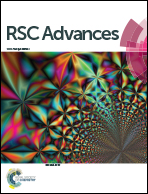Germanium-based superatom clusters as excess electron compounds with significant static and dynamic NLO response; a DFT study†
Abstract
Herein, the geometric, electronic, and nonlinear optical properties of excess electron zintl clusters Ge5AM3, Ge9AM5, and Ge10AM3 (AM = Li, Na, and K) are investigated. The clusters under consideration demonstrate considerable electronic stability as well as superalkali characteristics. The NBO charge is transferred from the alkali metal to the Ge-atoms. The FMO analysis shows fabulous conductive properties with a significant reduction in SOMO–LUMO gaps (0.79–4.04 eV) as compared with undoped systems. The designed clusters are completely transparent in the deep UV-region and show absorption in the visible and near-IR region. Being excess electron compounds these clusters exhibit remarkable hyperpolarizability response up to 8.99 × 10−26 esu, where a static second hyperpolarizability (γo) value of up to 2.15 × 10−30 esu was recorded for Ge9Na5 superatom clusters. The excitation energy is the main controlling factor for hyperpolarizability as revealed from the two-level model study. The electro-optical Pockel's effect and the second harmonic generation phenomenon (SHG) are used to investigate dynamic nonlinear optical features. At a lower applied frequency (=532 nm), the dynamic hyperpolarizability and second hyperpolarizability values are significantly higher for the studied clusters. Furthermore, for the Ge9K5 cluster, the hyper Rayleigh scattering (HRS) increases to 5.03 × 10−26 esu.



 Please wait while we load your content...
Please wait while we load your content...